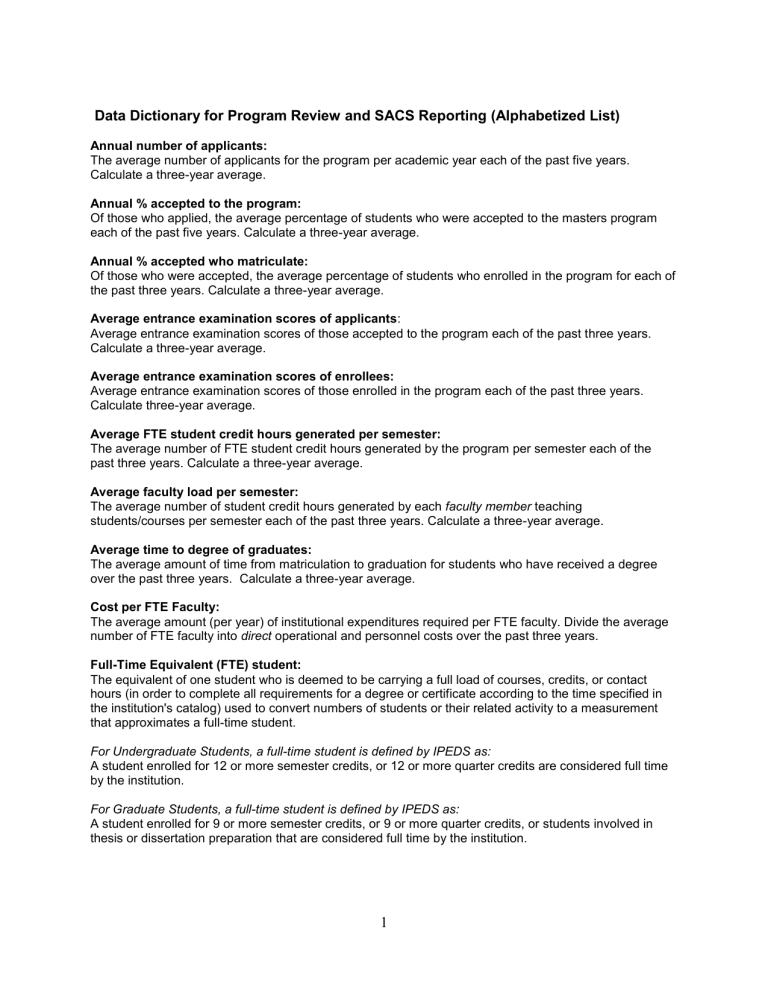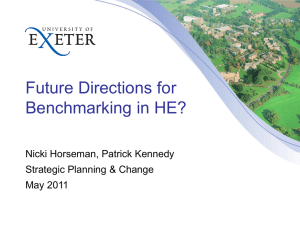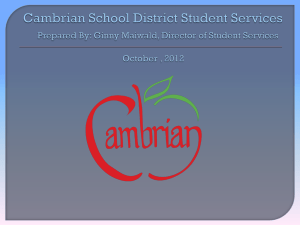Data Dictionary for Official Documents e.g., New Program Proposals

Data Dictionary for Program Review and SACS Reporting (Alphabetized List)
Annual number of applicants:
The average number of applicants for the program per academic year each of the past five years.
Calculate a three-year average.
Annual % accepted to the program:
Of those who applied, the average percentage of students who were accepted to the masters program each of the past five years. Calculate a three-year average.
Annual % accepted who matriculate:
Of those who were accepted, the average percentage of students who enrolled in the program for each of the past three years. Calculate a three-year average.
Average entrance examination scores of applicants :
Average entrance examination scores of those accepted to the program each of the past three years.
Calculate a three-year average.
Average entrance examination scores of enrollees:
Average entrance examination scores of those enrolled in the program each of the past three years.
Calculate three-year average.
Average FTE student credit hours generated per semester:
The average number of FTE student credit hours generated by the program per semester each of the past three years. Calculate a three-year average.
Average faculty load per semester:
The average number of student credit hours generated by each faculty member teaching students/courses per semester each of the past three years. Calculate a three-year average.
Average time to degree of graduates:
The average amount of time from matriculation to graduation for students who have received a degree over the past three years. Calculate a three-year average.
Cost per FTE Faculty:
The average amount (per year) of institutional expenditures required per FTE faculty. Divide the average number of FTE faculty into direct operational and personnel costs over the past three years.
Full-Time Equivalent (FTE) student:
The equivalent of one student who is deemed to be carrying a full load of courses, credits, or contact hours (in order to complete all requirements for a degree or certificate according to the time specified in the institution's catalog) used to convert numbers of students or their related activity to a measurement that approximates a full-time student.
For Undergraduate Students, a full-time student is defined by IPEDS as:
A student enrolled for 12 or more semester credits, or 12 or more quarter credits are considered full time by the institution.
For Graduate Students, a full-time student is defined by IPEDS as:
A student enrolled for 9 or more semester credits, or 9 or more quarter credits, or students involved in thesis or dissertation preparation that are considered full time by the institution.
1
Full-Time Equivalent (FTE) faculty:
Those members of the instruction/research staff who are employed full time and whose major regular assignment is instruction, including those with released time for research. Also, includes full-time faculty for whom it is not possible to differentiate between teaching, research and public service because each of these functions is an integral component of his/her regular assignment.
(Graduate Program Only): List of colleges and universities from which students present degrees for admission:
A list of colleges and universities from which students entering programs over the past three years have undergraduate degrees.
Overall Cost per FTE student:
The average total amount (per academic year) of institutional expenditures required per FTE student.
Divide the number of FTE students into the total direct operational and personnel costs over the past three years.
Net cost/return per FTE student:
The amount cost to the institution or the amount returned to the institution. Subtract revenue generated per FTE student from overall cost per FTE student.
Number of Faculty teaching in program:
The number (headcount) of faculty in each department who are teaching students. Divide the number of faculty teaching students/courses into the total number of faculty in the department for each of the past three years. Calculate the three year average.
Number of degrees conferred annually:
The number of graduate degrees conferred between June 30 th of the current year and July 1 st of the previous year. Show the degrees conferred for each of the past three years and a three-year average.
Percentage of dept. Faculty teaching students:
The percentage of FTE faculty generated by each department who teach students. Divide the number of
FTE faculty teaching students/courses into total FTE productivity over the past three years.
Percentage of graduates seeking employment who are employed upon graduation:
The percentage of graduates (who are NOT applying for an advanced degree) who are employed within 6 months of graduation each of the past three years. Calculate a three-year average.
Percentage of graduates employed in degree-related occupations:
Out of those graduates who are employed, the percentage employed in jobs directly relating to the field of study in which they received their master’s degree for each of the past three years. Calculate a three-year average.
Percentage of graduates applying for an advanced degree:
The percentage of students over the past three years who, upon completion of the program, apply to pursue an advanced degree. Calculate a three-year average.
Percentage of graduates accepted for advanced programs:
The percentage of students over the past three years who are accepted into advanced programs.
Calculate a three-year average.
Primary colleges/universities attended:
A list of colleges and universities accepting graduates over the past three years.
Revenue generated per FTE student:
The average revenue generated by each student paying fees to sustain enrollment in the program. Divide the total fees paid to the program by the number of FTE students paying fees.
2
Three-Year Averages:
Each calculation below should be presented in table form showing the data for each year as well as an aggregate three-year average. This will permit the reviewers to monitor changes over time.
3





